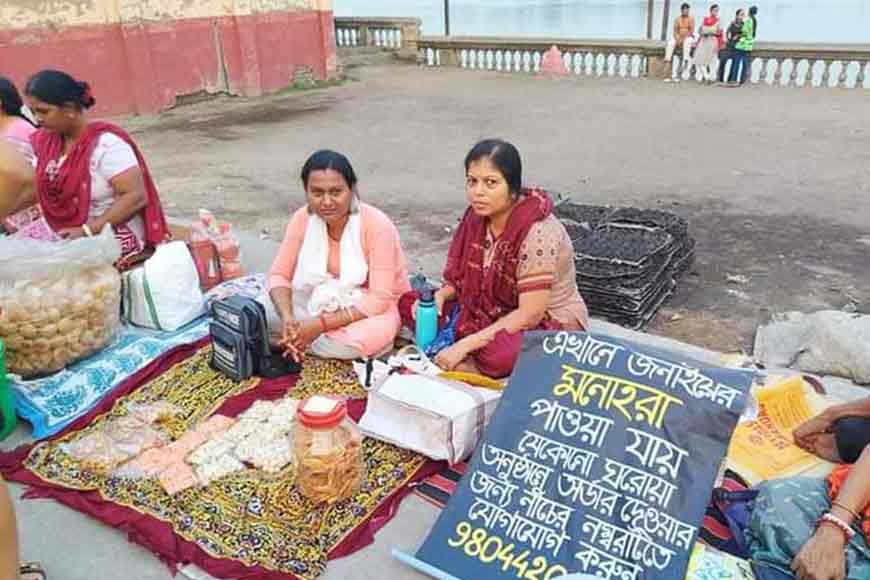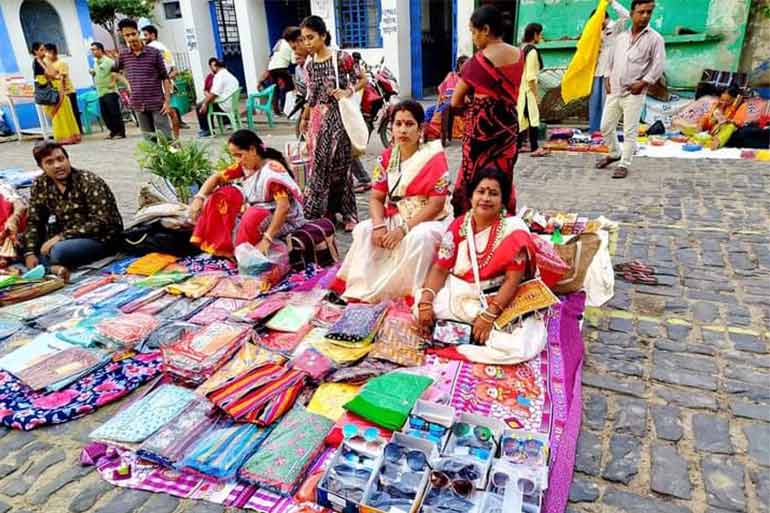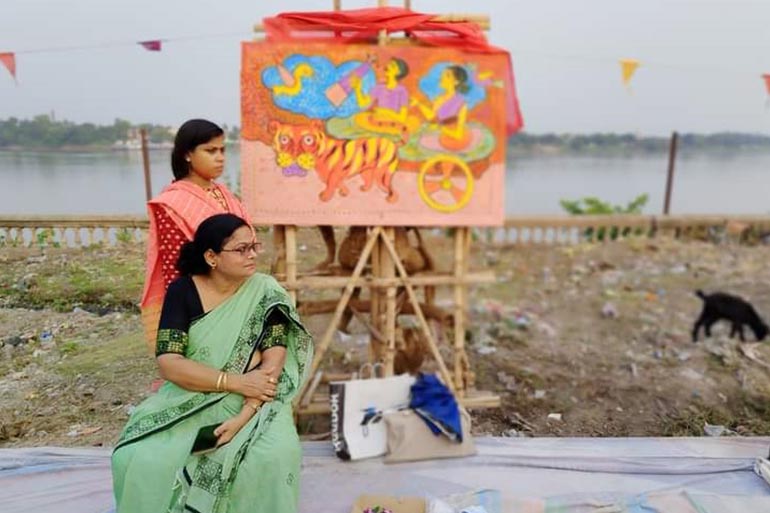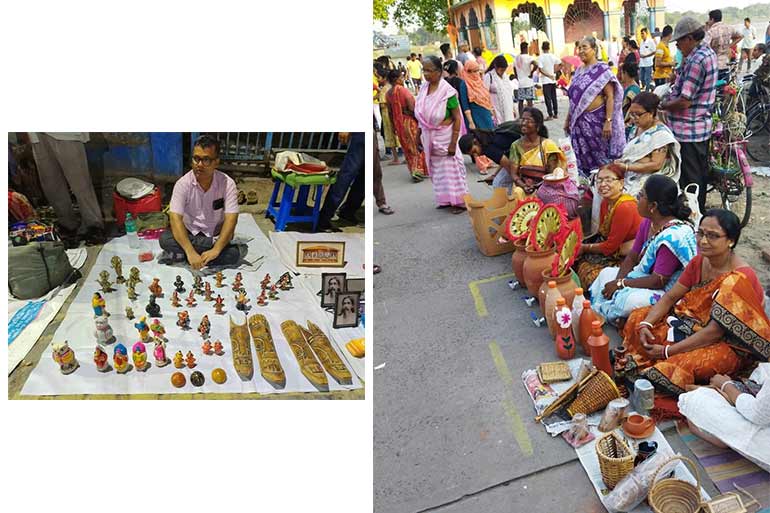Tatini Haat of Bhadreshwar brings local art and craft to the forefront. – GetBengal story

‘Haat’ is an integrated market that serves as a trading venue for local people in rural areas and towns. Haats are typically set up twice or three times per week. In some places, once every fortnight. In addition to providing trading opportunities, haat bazaars serve as meeting places for rural folks. In their poems titled "Haat," Jatindranath Sengupta and Rabindranath Tagore both masterfully capture the idea of a typical "haat." However, ‘haat’ is gradually losing its efficacy, and all that remains is a nostalgic memory of a bygone era.
Recent research has shown that in this era of shopping malls, rural markets have outpaced the growth of urban markets and will continue to do so in the years to come. In the future, going rural will no longer remain an option for big companies that aspire for strong market growth. More and more companies have been trying to capture the rural market over the past decade. Many factors are driving this mad rush, such as the saturation of urban markets, the expanding potential of rural markets, the rising income and educational attainment of rural consumers, the ease of communication in rural areas due to the widespread use of mobile devices, the internet, and satellite television, the aspirations of rural residents, etc.

Despite the convenience of online shopping, super markets, and malls, the weekly bazaars (haats) and fairs (melas) continue to be popular with the village folk. Amid this scenario, the people of Bhadreshwar of Hooghly were pleasantly surprised to witness a ‘haat’ unfold right before their eyes at Srimani Ghat, on the banks of the Ganga River. The weekly haat is a recent addition to Bengal’s attempt to reconnect with its roots. The haat was inaugurated two days after the Bengali New Year, on April 17, 2024, and is held once a week on Wednesdays.
Bhadreshwar is a small district town in Hooghly, named after Bhadreshwar Tala Temple, a 525-year-old Shiva temple. Legend has it that during the Treta Yuga, when Lord Vishnu took on the form of Rama, the phallic of Lord Shiva's rose to the surface on its own without the intervention of humans. Bhadreshwaris is referenced in "Mansamangal Kavya," arguably the oldest Mangal-Kavya in Bengali, which recounts the genesis of the worship of the snake-goddess Manasa. The ballad describes Chand Sadagar's staggering journey. During that time, Bhadreshwarganjport, along with its business centre, emerged as an important destination following the decline of the ancient Saptagram port on the banks of the Saraswati River. Due to the silting and subsequent drying up of the Saraswati River, the port of Saptagram had to be abandoned. It is said that Bhadreshwar was the biggest and wealthiest town between Calcutta and Kalna in the late 16th century.
Almost a century after Vasco da Gama landed on the West Coast of India (1498), the Europeans started making inroads in Bengal. Using Hooghly, aka the Ganga River, as the main source of navigation, they started making inroads in Bengal. In the 17th century, the Portuguese, French, German, English, Danish, and Dutch merchants established their bases in the bustling towns on the banks of the Hooghly River, towns like Chandernagore, Chinsurah, Srirampore, Konnagar, etc., and business and trade flourished. Bhadreshwarganj was a renowned trading centre during this period. Areas like Lakshmiganj, Mahajanpatti, Shonpatti, Shrimani Ghat, and Noongola were bustling trading centres dealing with rice, jaggery, ghee, salt, silk, jute, et al. There was a warehouse on the bank of the river and large container boats anchored in the river port to load and unload goods.

In Bhadreshwarganj, local traders dealt with foreign traders. Traders were eventually lured to travel by land routes to conduct business in the hinterland. Compared to using rivers, this was seen to be safer. All trade and business were drawn to Calcutta's port. Not far away, new settlements, such as Sheoraphuli, arose. As a result, Bhadreshwarganj's once-great glory progressively diminished. In order to recreate and remind people of the beautiful past of this old town and its culture, a group of history buffs from Bhadreshwar came up with the idea to develop a weekly "haat" (open-air market place) along the riverfront every Wednesday. The bazaar, christened Tatini Haat, aims to attract locals as well as people from other cities and towns to leave behind the uber-rich, ultra-modern urban residences and take a nostalgic walk down memory lane. Shaktipada Bhattacharya, a former Bhadreshwari teacher, researcher, and history enthusiast, stated: "That ancient 'Ganj' may not be revived to its glorious past, but we are recreating the feel of a haat and familiarising the masses with the appearance of Ganj at that time." We are trying to recreate the old aura with our wide array of lost or fast-vanishing food items, folk items, and handicrafts. When most people head to shopping malls or department stores for their provisions, we are trying to entice them to experience the informal feel of the ‘Grameen Haat’ (village marketplace). These entrepôts of trade (Ganj) and warehouses prove Bengalis’ skills and supremacy as traders. We have arranged to display this lesser-known history for all. People come to this market to learn about and celebrate the glorious history of the town. That is an achievement for us.”
Bhadreshwar-based NGO Bhraman Adda, in collaboration with Bhadreshwar Municipality, has taken a major step to revive the haatculture at Srimani Ghat every Wednesday. Much like the Sonajhurir Haat in Santiniketan, local artisans and businessmen are doing brisk business at this open marketplace, christened Tatini Haat. Items like bori (dried lentil dumplings) of different types and homemade pickles are hot favourites among the buyers. Locally made shellac and wooden dolls and other toys, earthen pitchers, dokra sculptures, palm leaf fans, fresh spices, eco-friendly bags, incense sticks, candles, handmade costume jewellery, and other handicraft items are the major draw in the haat.
In addition, tree saplings, garments, books, and tea are also sold here. Farmers put up stalls to sell locally produced, freshly plucked fruits and vegetables. A unique feature of this haat is that people are encouraged to bring old, unused garments, which are collected and distributed among the needy free of charge. The full-throated renditions of minstrels and folk musicians create a magical world on the banks of the river.
The organisers are committed to reducing pollution and have totally banned the use of plastic in the haat. They have left no stone unturned to keep noise pollution to a minimum. Instead of selling popular fast-food items like rolls and chowmien at the haat, vendors have been encouraged to sell traditional homemade murir moa (sweet crunchy balls prepared with puffed rice and jaggery), NarkelTakti (sweet meat prepared with shredded coconut), Jilipi, Ghughni, Alur Dum, Ampora Sherbat (roasted raw mango sherbet), et al. The one-day haat takes place every Wednesday between 4 and 7 p.m. Many people, particularly the younger ones, are thronging the haat regularly and are buying wares made by the local artisans to encourage them.

The haat has presented an excellent opportunity for rural women to become self-reliant. Shaktipada Babu, one of the officials of the 'Bhraman Adda' organisation, said, "The market, which started with 30–40 women vendors, now has 125 women sellers. Another 50 are waiting. We encourage women to participate, and self-help groups are showing keen interest in the project. Many of these groups have already participated, and others are waiting in the wings.”
Amid the socio-cultural diaspora, Bhadreshwar has consciously selected a different route. When cities and suburbs are sinking into a cultural abyss of oblivion, the locals of the town are striving to revive the glorious past of Bhadreshwarganj. Setting up the Haat is part of that effort to revive the fame of the town as a business hub. Shaktipada Babu emphasises recollecting and celebrating the traditions of those bygone days and assures that we, as Bengalis, should not mourn about the past. Not all is lost yet. Bengal’s indigenous art and culture thrive in its villages and in the creations of local artists and artisans. Tatini Haat is a journey down memory lane.










